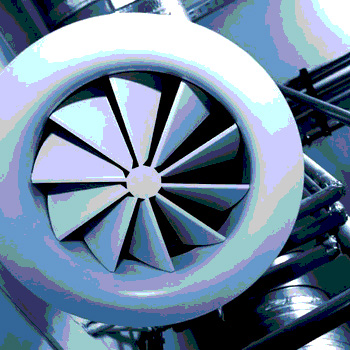The hot summer weather invites employees in any workplace to find creative ways to stay cool. In food processing plants in particular, it’s possible to see windows cracked open or doors left ajar as workers seek to offset the heat. While such measures can bring temporary relief, these practices may be letting more than a breeze into the facility.
Air quality is often overlooked as a source of contamination in food processing environments. However, a 2012 Parker Hannifin white paper found that a 75-hp air compressor with a capacity of 300 standard cubic feet per minute takes in up to 1 million bacteria hourly, with these potential contaminants capable of remaining airborne for extended periods of time.
In particular, sections of the plant where air is not restricted by physical or mechanical means are most susceptible to contamination due to poor air quality. Environmental areas which may not be cleaned and sanitized as frequently as food contact surfaces can be havens for bacterial and fungal microbes. Likewise, the introduction of outside air in these locations can invite uncontrolled water, dust, bacteria, yeast and mold into previously clean work stations.
As the food industry faces greater pressure to ensure consumer safety, how can processors combat an invisible contamination threat?
While there is an increasing need for processing plants to diligently monitor air quality for possible food safety hazards, the industry has yet to set universal testing standards. As a result, each plant is subject to its management team’s independent definition of air quality specifications and testing best practices. This lack of uniform standards makes it more difficult to identify and address contamination threats across diverse food industries.
The busy summer season, when plant air is more microbiologically variable and contamination threats increase, is the perfect time for processors to warm up to a more refined and consistent testing and safety management program. Whether plants are exploring proper testing protocols for the first time, or simply looking to address previously undetected operational gaps, the following criteria can help processors ensure their air “passes the test” and protects the health of both employees and consumers.
Test Thoroughly and Repeatedly
In any plant environment, instituting a successful air quality monitoring program begins with defining the most appropriate testing schedule based on the type of food products being manufactured. Processors of ready-to-eat foods and products designed for immediate consumption should test air conditions daily or weekly. Likewise, processors of foods which require cooking, heating, freezing or another intervention step which can kill potential contaminants, may only require monthly or quarterly testing.
Microbiological air testing typically occurs through sedimentation or centrifugal approaches. Sedimentation testing captures microorganisms on an agar plate as they fall from the air to the surface. While this approach offers a low-cost way for plant teams to identify elevated general risk areas and specific microbes that may impact food safety, sedimentation testing requires time and patience and can produce inconsistent results. Plants desiring a more rapid measurement approach can implement centrifugal testing, in which a mechanical unit impinges air onto the agar plate for real-time air contamination evaluation. Industry resources, such as the 2004 article “Successful Sampling Program, Part III: Environmental Air and Surface Techniques,” can provide further criteria to help processing plants determine which measures best accommodate their unique operations.
Processors should additionally complete seasonal baseline air quality testing to gauge the impact of weather and other seasonal conditions. Through this expanded visibility, plant safety managers can evaluate potential spikes in contamination volume and immediately address areas of need.
Test your Filter Strength
Throughout ready-to-eat food processing facilities, exposing external air to food contact surfaces immediately before packaging could lead to the delivery of contaminated products to retailers and consumers. In most cases airborne microbes, such as Bacillus or lactic acid bacteria, pose their greatest threat through spoilage, which can change products’ organoleptic properties. However, in the most severe cases, pathogen-contaminated products can make consumers ill. With every distributed product, processors’ and retailers’ bottom lines, as well as consumer trust and reputation, are at stake.
These risks make efficient filtration critical. While food processing plants cannot control the components of inbound air, treatment and recirculation can help improve the quality of the air surrounding food prior to packaging.
Similar to baseline testing criteria, filter evaluation and replacement frequency demands will vary in each plant. The dirtier the filter, the greater the risk. Processing environments that emit powder or dust may need to replace their filters weekly or twice-monthly, depending on the volume of airborne particulates. Even if filters appear clean during visual inspection, plant teams should still demonstrate caution and replace them every 2–3 months.
Test with the Eyes
While thorough mechanical testing can highlight significant air quality risks, sometimes observation is the most efficient testing plant safety teams can conduct.
Walking plant floors frequently can identify the trends and behaviors behind certain air contamination risks. Keeping watch of which rooms employees travel through and frequent most will offer a strong indication of where doors and windows are most likely to be left open. Walk-throughs can also spotlight possibly undetected incoming air sources, such as leaky windows and foundational cracks and crevices, which can either be repaired with plastic protection strips or mechanical curtains to restrict air flow.
Perhaps the most fundamental air quality enhancement procedure plant safety managers can take is simply reinforcing best practices or Good Manufacturing Practices with employees. Helping employees understand the risks and potential consequences of leaving a door or window open for even a few minutes will transition safety protocol execution to the floor level and generate responsibility among teams to better protect products and users.
The air contamination prevention and quality management needs of each plant will vary depending on production frequency and output, and there is no universal set of safety protocols that will ensure completely clean air in every processing plant. However, the plant teams that recognize the potential dangers that are blowing in the wind, and who are willing to identify and implement thorough testing procedures, will be in the best position to ensure product, employee and consumer protection from dangerous microbes and bacteria.
For any plant, close consultation with their hygiene and sanitation partners can help define the testing procedures and operational improvements that will deliver the greatest safety results. While implementing new strategies may require time, effort and resources, cleaning up air now can save processors from potentially having to clean up contamination complications later.
Stephanie Sparks is sector specialist/field microbiologist for Sealed Air Corporation.




